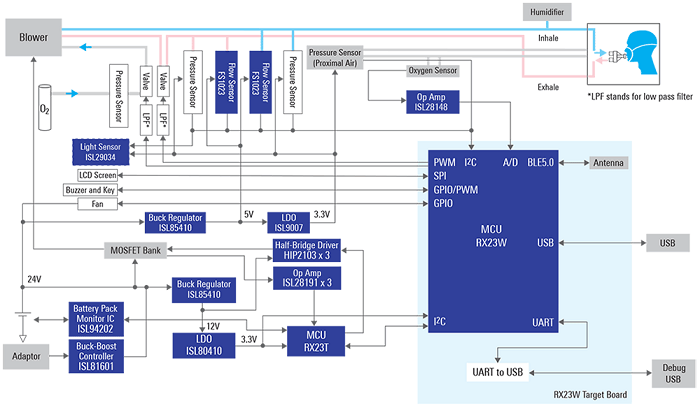By Gina Roos, editor-in-chief
Using several open-source ventilator designs recently released into the public domain due to the coronavirus pandemic, Renesas Electronics Corp. has developed an open-source ventilator system reference design, which enables medical OEMs to design ready-to-assemble boards for medical ventilators. Many countries, including the U.S., face a critical shortage of ventilators due to the COVID-19 pandemic. About 880,000 more ventilators are needed globally, according to data and analytics firm GlobalData.
Component manufacturers like Renesas are ramping up their designs and manufacturing, based on their respective areas of expertise, to help develop respiratory devices in short supply.

The Renesas team followed several open-source ventilator designs, including the Medtronic PB560 and MIT’s open-source E-Vent project, to develop a three-board ventilator design.
“As part of the development process, Renesas researched many available public sources for ventilator system designs, including the Medtronic PB560, which was the most complete,” DK Singh, Renesas’s director, Systems and Solutions, told Electronic Products. “Renesas also looked at MIT’s open-source E-Vent project, other smaller block designs, and a variety of Honeywell sensor products and technology for medical applications.
“We also reached out to a couple of doctors for their input to develop the current architecture of the Renesas ventilator system ,” Singh added.

System block design (Image: Renesas)
This reference design is for portable ventilators for non-ICU use cases, providing high-pressure oxygen to patients in assist-control or pressure-control modes. It controls the tidal volume and gas mixture while monitoring the patient’s status. It can be used with or without gas tanks, and a humidifier can be connected to the intake path.
Recommended
COVID-19: 3D printing drives new open-source designs for ventilators
The reference design uses 20 Renesas ICs, including microcontrollers (MCUs), power, and analog ICs to handle many of the ventilator’s signal-chain electrical functions. It uses two MCUs for higher safety, said Renesas, so the devices can monitor and reset each other.
The system design integrates a sensor board and a motor control board. It also includes Bluetooth connectivity, which allows several patients to be monitored simultaneously via a tablet or other mobile device. The MCU on each board is used to control its specific task while monitoring the status of the connecting board.
In addition, the ventilator design provides a system of checks and balances to enable regulatory approval and patient safety, said Renesas. The company also offers several other solutions for medical devices used to treat patients with the coronavirus.
Advertisement
Learn more about Electronic Products MagazineRenesas Electronics America





